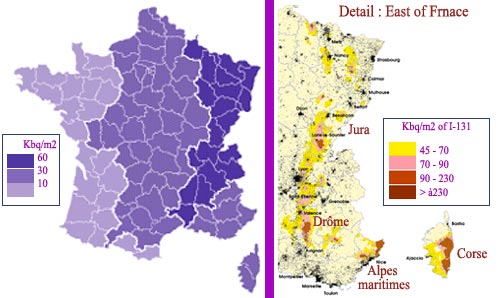A dangerous radioelement during the first weeks
Iodine-131 is the most feared fission product when released into the atmosphere after the atomic bomb explosions or an accident like Chernobyl. The danger comes from its volatility and high radioactivity. Breathed, it concentrates on the thyroid and is the cause of cancers of this sensitive gland that fixed iodine.

Iodine-131 contamination of the food chain
During the hours and days following an accidental release, inhalation of radioactive iodines is the primary route of assimilation. Then it is through food and especially milk contamination that it occurs. Inhalation risk is reduced by wearing masks, closing windows and staying indoors. Afterwards, it is through food and especially milk that it occurs. Milk contamination is avoided by returning the cows to the barn and feeding them with uncontaminated fodder. Fresh milk should be avoided, especially for children.
© IRSN/dessin : Martine Beugin (Source G.Gerber)
Experts believe that iodine-131 was responsible for 46% of the activity dispersed after the explosion of the reactor. During the first hours, other radioactive isotopes contribute, iodine 133 and 132, whose lifetimes are even shorter. The iodine short lifetimes generate a fast decrease with time of the iodine risk. The activity of iodine-131 activity is divided by 14 times in one month, 2700 in a quarter.
This disappearance led to a special prevention technique. In the case of exposure, one has to prevent the uptake of radioactive iodine. By absorbing non-radioactive iodine pills, one saturates the thyroid which no longer assimilates the dangerous isotope. This gives time to go a less contaminated area and allows to wait for the disappearance of iodine-131. Iodine pills often come too late for inhalation, but are useful for preventing exposures folowing pills uptakes. One must give them in priority to children, teens and pregnant women but not to the elderly
Soviet authorities were not able to distribute preventive pills in the Chernobyl area. Iodine-131 uptake generated thyroid cancer, especially among the most sensitive children. Fourteen years after the disaster, an excess of 1800 thyroid cancer was observed. This wave of cancers had not been foreseen at the time by radiological protection experts who had expected instead an increase of leukemia. These cancers screened early and taken timely are curable in principle. This was the case, but the deplorable health situation in the former Soviet Union aggravated the tragedy.

May 1986, France : Map of I-131 deposits
Maps of iodine-131 and Cesoum-137 are similar following the same pattern. In early may 1986, iodine-131 surface activities were 5 to 10 times these of cesium-137, but they were halved every 8 days and divided by 1000 every 80 days. At the end of june, iodine had practically vanished. West of France ittle affected, the most contaminated departments lying east of a line Gard-Moselle. © IRSN
In France, the exposure to iodine-131 was in general low
In France, exposures were in average much lower. Mountainous regions like the Alps and Corsica were the most contaminated, because they stopped the cloud, which stood at an altitude of 1500-3000 meters. Rains then washed the atmosphere bringing the radioactivity to the ground.
The incidence of thyroid cancer in Corsica which was discussed in publicized law suits is unlikely. The Island is not known for its cattle and milk production. The milk drunk by children and newborns was imported from the continent…
French authorities did not distribute preventive iodine pills mainly because the exposures were estimated low in average. This non-distribution had no significant effects, but was criticized and not understood by the public. Since then, authorities have stockpiled such pills and would distribute them to people at risk.
NEXT : Chernobyl, Cesium 137
Other articles on the subject « Chernobyl accident »
Chernobyl Circumstances
An explosion followed by a graphite fire In 1986 the Ukrainian Chernobyl plant had 4 RBMK reactor[...]
Chernobyl Liquidators
A heavy toll paid by firefighters and liquidators: The magnitude of the disaster took the Soviet [...]
Radioactive Releases
Radioactive releases and contaminations at Chernobyl The explosion of the reactor led to the disp[...]
Chernobyl Plume
A deep mark in the french collective unconscious « The Chernobyl cloud has stopped at the french [...]
Chernobyl Exclusion Zone
A no man’s land turned into a natural reserve ? On April 27th, 1986, one day after the expl[...]
Chernobyl Health Effects
Chernobyl: A toll still impossible to quantify It is difficult to reach an approached assessment [...]
Chernobyl Caesium-137
The accident long term legacy More than twenty years after the Chernobyl accident, attention focu[...]
Chernobyl Today
The Chernobyl Site Over 30 Years Later On December 15, 2000, the Ukrainian government, in accorda[...]